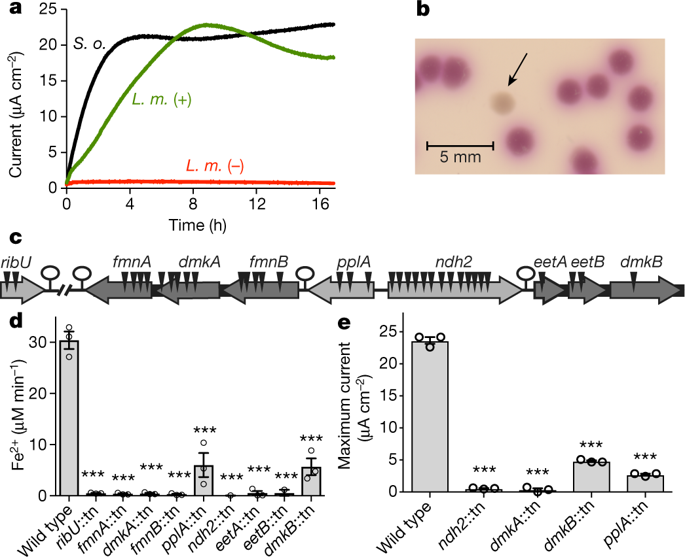Our official English website, www.x-mol.net, welcomes your
feedback! (Note: you will need to create a separate account there.)
A flavin-based extracellular electron transfer mechanism in diverse Gram-positive bacteria
Nature ( IF 50.5 ) Pub Date : 2018-09-12 , DOI: 10.1038/s41586-018-0498-z Samuel H Light 1 , Lin Su 2, 3 , Rafael Rivera-Lugo 1 , Jose A Cornejo 2 , Alexander Louie 1 , Anthony T Iavarone 4 , Caroline M Ajo-Franklin 2 , Daniel A Portnoy 1, 5
Nature ( IF 50.5 ) Pub Date : 2018-09-12 , DOI: 10.1038/s41586-018-0498-z Samuel H Light 1 , Lin Su 2, 3 , Rafael Rivera-Lugo 1 , Jose A Cornejo 2 , Alexander Louie 1 , Anthony T Iavarone 4 , Caroline M Ajo-Franklin 2 , Daniel A Portnoy 1, 5
Affiliation

|
Extracellular electron transfer (EET) describes microbial bioelectrochemical processes in which electrons are transferred from the cytosol to the exterior of the cell1. Mineral-respiring bacteria use elaborate haem-based electron transfer mechanisms2–4 but the existence and mechanistic basis of other EETs remain largely unknown. Here we show that the food-borne pathogen Listeria monocytogenes uses a distinctive flavin-based EET mechanism to deliver electrons to iron or an electrode. By performing a forward genetic screen to identify L. monocytogenes mutants with diminished extracellular ferric iron reductase activity, we identified an eight-gene locus that is responsible for EET. This locus encodes a specialized NADH dehydrogenase that segregates EET from aerobic respiration by channelling electrons to a discrete membrane-localized quinone pool. Other proteins facilitate the assembly of an abundant extracellular flavoprotein that, in conjunction with free-molecule flavin shuttles, mediates electron transfer to extracellular acceptors. This system thus establishes a simple electron conduit that is compatible with the single-membrane structure of the Gram-positive cell. Activation of EET supports growth on non-fermentable carbon sources, and an EET mutant exhibited a competitive defect within the mouse gastrointestinal tract. Orthologues of the genes responsible for EET are present in hundreds of species across the Firmicutes phylum, including multiple pathogens and commensal members of the intestinal microbiota, and correlate with EET activity in assayed strains. These findings suggest a greater prevalence of EET-based growth capabilities and establish a previously underappreciated relevance for electrogenic bacteria across diverse environments, including host-associated microbial communities and infectious disease.The Gram-positive Listeria monocytogenes pathogen possesses a distinctive extracellular electron transfer mechanism, which is probably present in numerous ecologically diverse species of the Firmcutes phylum.
中文翻译:

多种革兰氏阳性菌中基于黄素的细胞外电子转移机制
细胞外电子转移 (EET) 描述了微生物生物电化学过程,其中电子从细胞溶质转移到细胞外部 1。矿物呼吸细菌使用复杂的基于血红素的电子转移机制 2-4,但其他 EET 的存在和机制基础仍然很大程度上未知。在这里,我们展示了食源性病原体单核细胞增生李斯特菌使用独特的基于黄素的 EET 机制将电子传递到铁或电极。通过执行正向遗传筛选以识别细胞外三价铁还原酶活性降低的单核细胞增生李斯特菌突变体,我们确定了一个负责 EET 的八基因位点。该基因座编码一种专门的 NADH 脱氢酶,通过将电子引导到离散的膜定位醌池,将 EET 与有氧呼吸分离。其他蛋白质促进丰富的细胞外黄素蛋白的组装,与游离分子黄素穿梭结合,介导电子转移到细胞外受体。因此,该系统建立了一个简单的电子管道,与革兰氏阳性细胞的单膜结构兼容。EET 的激活支持不可发酵碳源的生长,并且 EET 突变体在小鼠胃肠道内表现出竞争缺陷。负责 EET 的基因的直向同源物存在于厚壁菌门的数百种物种中,包括多种病原体和肠道微生物群的共生成员,并与测定菌株中的 EET 活性相关。
更新日期:2018-09-12
中文翻译:

多种革兰氏阳性菌中基于黄素的细胞外电子转移机制
细胞外电子转移 (EET) 描述了微生物生物电化学过程,其中电子从细胞溶质转移到细胞外部 1。矿物呼吸细菌使用复杂的基于血红素的电子转移机制 2-4,但其他 EET 的存在和机制基础仍然很大程度上未知。在这里,我们展示了食源性病原体单核细胞增生李斯特菌使用独特的基于黄素的 EET 机制将电子传递到铁或电极。通过执行正向遗传筛选以识别细胞外三价铁还原酶活性降低的单核细胞增生李斯特菌突变体,我们确定了一个负责 EET 的八基因位点。该基因座编码一种专门的 NADH 脱氢酶,通过将电子引导到离散的膜定位醌池,将 EET 与有氧呼吸分离。其他蛋白质促进丰富的细胞外黄素蛋白的组装,与游离分子黄素穿梭结合,介导电子转移到细胞外受体。因此,该系统建立了一个简单的电子管道,与革兰氏阳性细胞的单膜结构兼容。EET 的激活支持不可发酵碳源的生长,并且 EET 突变体在小鼠胃肠道内表现出竞争缺陷。负责 EET 的基因的直向同源物存在于厚壁菌门的数百种物种中,包括多种病原体和肠道微生物群的共生成员,并与测定菌株中的 EET 活性相关。











































 京公网安备 11010802027423号
京公网安备 11010802027423号